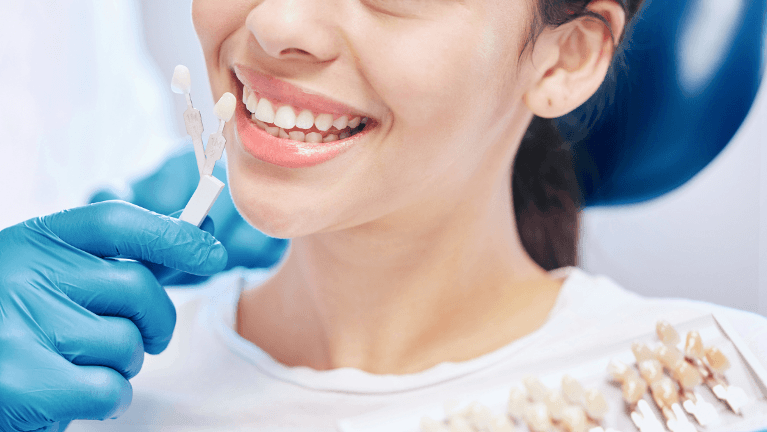
It’s vital for people with dental crowns to understand what to do if a crown comes loose. While it can be unsettling, taking the right steps to manage the situation can help you avoid pain and complications. Today, we discuss the potential causes of loose crowns, what you should do, and how to care for the tooth until you can see your dentist.
Understanding Why Crowns Come Loose
Before we discuss emergency measures, it can be helpful to understand why crowns become dislodged. The most common cause is the gradual breakdown of the dental cement holding the crown in place. This breakdown typically happens due to regular wear and tear over several years. However, frequently eating sticky foods or grinding your teeth can accelerate the process.
A less common cause of loose crowns is decay developing under the crown. Decay can form due to poor oral hygiene or excessive consumption of sugary foods and drinks. In other cases, trauma to the mouth, such as direct hits in contact sports, can loosen a crown. Patients also damage their crowns by biting hard foods or using their teeth to open drinks or remove packaging.
Immediate Steps When Your Crown Comes Loose
When you realize your crown has come loose, staying calm and assessing the situation is vital. If the crown is still partially attached to the tooth but is no longer in position, seeing your dentist as soon as possible is important. Until then, treat the tooth cautiously and avoid biting or chewing with it.
If the crown has completely separated from the tooth, remove it to avoid swallowing it. Rinse the crown and tooth with warm water, but do not use hot or cold water as the exposed tooth may be very sensitive. If the crown has cracked or broken, ensure you have all the pieces and store the crown safely until you see your dentist. You can keep the crown in a Ziploc bag so it isn’t damaged or lost.
Managing Pain and Discomfort
The natural tooth under a crown is particularly vulnerable once exposed. Without the protective cover of a crown, your tooth may be extremely sensitive to temperature and pressure. Avoid chewing on that side of your mouth to minimize discomfort, and skip foods and beverages at extreme temperatures.
Maintaining good oral hygiene is crucial, but you must be especially gentle when brushing as it can cause irritation. After eating, you can also rinse your mouth with salt water to remove debris. Do not eat anything sticky like chewing gum or toffees because the filling under the crown can also come loose if not treated with care.
Temporary Solutions for Crown Reattachment
If you cannot see your dentist immediately, there are some ways to protect your tooth. Dental cement, available at most pharmacies, can temporarily reattach your crown. You should only use this method if the crown is still whole and has been thoroughly cleaned and dried.
Avoid using too much pressure when placing the crown, and follow the product instructions carefully. Remember that this is only a short-term solution, and you should see your dentist as soon as possible. A loose crown is a dental emergency and should be treated as such. Without proper care, you could damage your natural tooth.
When Not to Attempt Self-Repair
While temporary dental cement can be helpful in some situations, there are times when you should not reattach the crown. Depending on your circumstances, attempting a repair can do more harm than good. If you meet the following criteria, schedule an emergency dental appointment:
- Your crown is cracked or broken
- There is visible decay on the underlying tooth
- The tooth itself is broken
Preventing Future Crown Issues
Once your dentist has reattached or replaced your crown, it’s important to prevent similar problems in the future. Important preventative steps include maintaining excellent oral hygiene, being mindful of the foods you eat, and addressing issues with teeth grinding. Regular dental check-ups are also crucial, as your dentist will spot potential problems before they become emergencies.
When to Seek Emergency Care
While a loose crown doesn’t necessarily warrant a trip to the emergency room, some situations require immediate medical attention. If you experience severe pain, significant bleeding, or signs of infections such as swelling or fever, don’t delay seeking help. Dr. Nargiz Zadeh’s dental practice is equipped to handle dental emergencies, and we will ensure you’re seen as soon as possible or referred to a trusted emergency service.
Take Control of Dental Crown Emergencies
Remember that while temporary solutions exist, they are not substitutes for professional dental care. The sooner you see your dentist, the better the outcome will be. If your crown has come loose or is no longer in the right position, contact Dr. Nargiz Zadeh. We will evaluate the condition of your crown and tooth and address any underlying issues.
A loose crown, while concerning, is a manageable situation when handled properly. Ensure you properly care for the exposed tooth, make an appointment, and minimize discomfort. Your dentist is the best resource for addressing this issue, so don’t hesitate to reach out if you experience problems with your dental crowns.